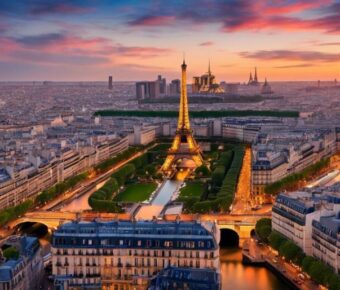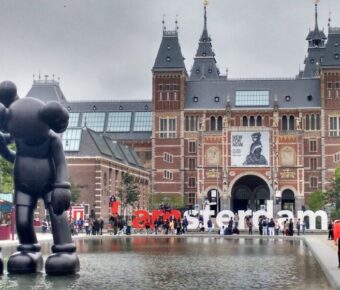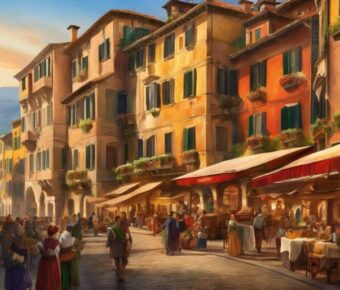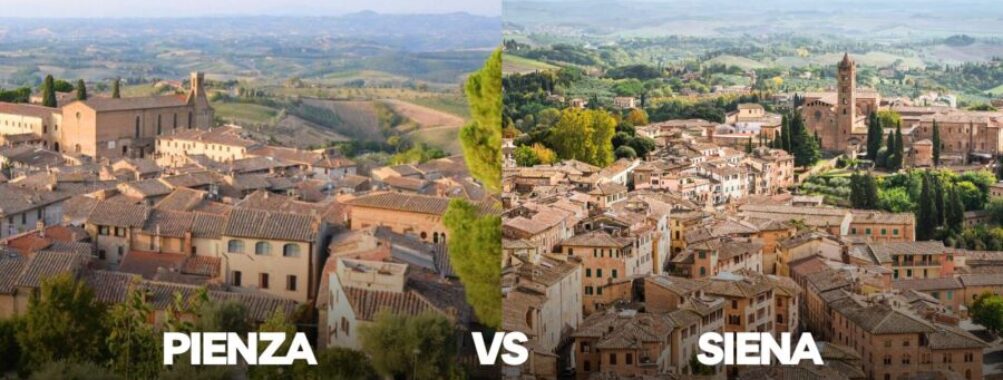
Pienza vs Siena: Which Hidden Tuscan Gem Offers the More Authentic Italian Experience?
Choosing between Pienza and Siena presents travelers with a classic Tuscan dilemma. These two gems offer entirely different experiences in the heart of Italy’s most famous region.
Siena provides a bustling medieval city atmosphere with steep hills and urban energy, while Pienza delivers a quieter, more intimate small-town experience with easier parking and walkability. The contrast between these destinations shapes how visitors will experience their Tuscan adventure.
Both towns claim spots on many travelers’ must-see lists, yet they serve different types of tourists. Siena draws those seeking a larger historic center with shops, restaurants, and cultural sites. Pienza appeals to visitors who prefer to base themselves in a charming village surrounded by the rolling hills and cypress trees of the Val d’Orcia.
Contents
- Historical Significance
- Origins of Pienza
- Siena’s Medieval Past
- UNESCO World Heritage Status
- Architectural Highlights
- Cathedral of Siena
- Pienza’s City Layout
- Cultural Experiences
- Traditional Festivals
- Cuisine and Gastronomy
- Artisanship in Tuscany
- Natural Landscapes
- Val d’Orcia Natural Park
- Tuscan Countryside
- Travel and Accessibility
- Getting to Pienza and Siena
- Accommodations and Stay
- Itineraries and Day Trips
- Pienza for History Buffs
- Siena’s Charm for Food Lovers
- Exploring Surrounding Towns
- Shopping and Retail
- Local Markets in Siena
- Boutiques of Pienza
- Frequently Asked Questions
- What unique attractions can visitors discover in Pienza?
- How does the historical significance of Siena compare to that of Pienza?
- Can Pienza serve as a strategic hub for exploring the wider Tuscany region?
- What are the can’t-miss cultural experiences when visiting Siena?
- How do the culinary offerings in Pienza stand out from those in nearby Tuscan towns?
- What time of year is optimal for experiencing the festivals and events in Siena?
- More Travel Guides
Historical Significance

Pienza and Siena represent crucial chapters in Tuscany’s rich architectural and cultural heritage. Each city showcases distinct periods that shaped Italian history through its preserved buildings, urban planning, and artistic achievements.
Origins of Pienza

The story of Pienza started as a small medieval village called Corsignano. In 1458, Enea Silvio Piccolomini became Pope Pius II and decided to transform his birthplace into an ideal Renaissance city.
He hired architect Bernardo Rossellino to redesign the town. The transformation took just three years, from 1459 to 1462.
The new city became the first example of Renaissance urban planning. The main square features the stunning Palazzo Piccolomini with its elegant loggia overlooking the Val d’Orcia valley.
Siena’s Medieval Past
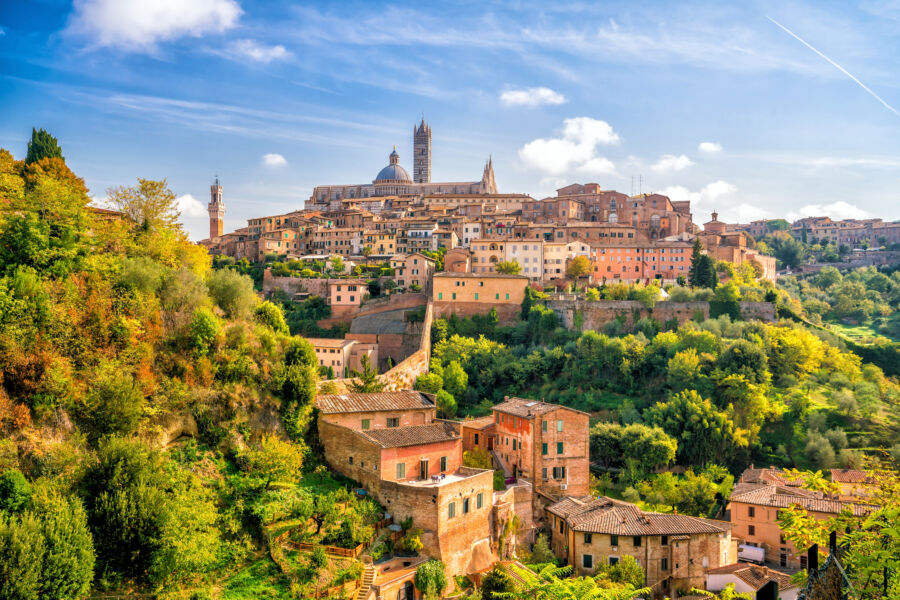
Siena rose to power as a central banking and trading center during the Middle Ages. The city reached its golden age in the 13th and 14th centuries.
The mighty Palazzo Comunale and the striking black-and-white marble Duomo symbolize Siena’s wealth and influence during medieval times.
The city’s unique fan-shaped Piazza del Campo hosted civic events and remains one of Europe’s greatest medieval squares. Its design reflects Siena’s innovative approach to urban planning.
UNESCO World Heritage Status

Pienza earned UNESCO recognition 1996 for its perfect Renaissance architecture and urban design. The historic center showcases the period’s ideals of rational planning and beautiful proportions.
Siena joined the UNESCO list in 1995. The organization praised its preserved medieval character and the way it adapted to the hilly terrain.
The Val d’Orcia area around Pienza also gained UNESCO status in 2004. This protected status helps preserve both cities’ authentic character and architectural treasures.
Architectural Highlights

Both cities showcase remarkable Renaissance architecture, though they express it quite differently. Siena’s grand Gothic cathedral contrasts with Pienza’s perfectly planned Renaissance layout.
Cathedral of Siena

The Duomo of Siena is one of Italy’s most impressive Gothic cathedrals. Its striking black-and-white marble stripes make it instantly recognizable.
The cathedral floor contains 56 etched marble panels depicting biblical scenes and local stories. These incredible works of art took local craftsmen nearly 200 years to complete.
The cathedral’s façade blends Gothic and Romanesque styles with intricate carvings, statues, and mosaics. Its bell tower, which reaches 77 meters high, offers fantastic views over Siena’s terracotta rooftops.
Pienza’s City Layout

Pope Pius II transformed his hometown into the first planned Renaissance city in the 1400s. He hired architect Bernardo Rossellino to create an ideal urban space in the Val d’Orcia.
The stunning Piazza Pio II sits at the heart of Pienza. This perfectly proportioned square hosts the city’s main buildings – the Cathedral, Palazzo Piccolomini, and the Town Hall.
Palazzo Piccolomini stands out with its elegant design and hanging gardens. From its loggia, visitors can take breathtaking views of the Val d’Orcia countryside and Monte Amiata.
The town’s main street, Corso Rossellino, connects the two main gates. Its Renaissance palaces and churches create a harmonious urban landscape that earned Pienza UNESCO World Heritage status.
See Related: 10 Day Italy Trip Cost: Budget Your Dream Vacation
Cultural Experiences
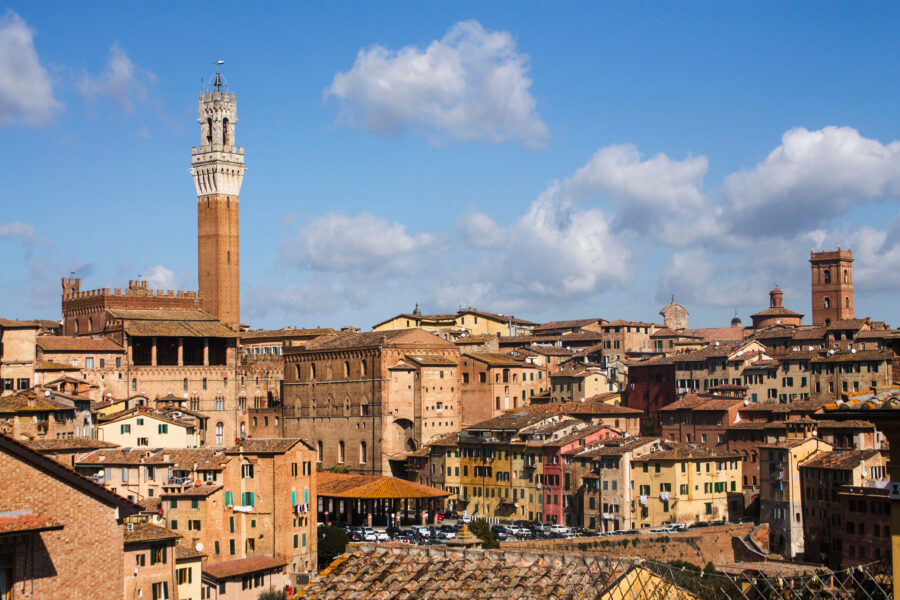
Siena and Pienza offer rich cultural traditions that showcase Tuscany’s heritage through festivals, food, and local crafts.
Traditional Festivals
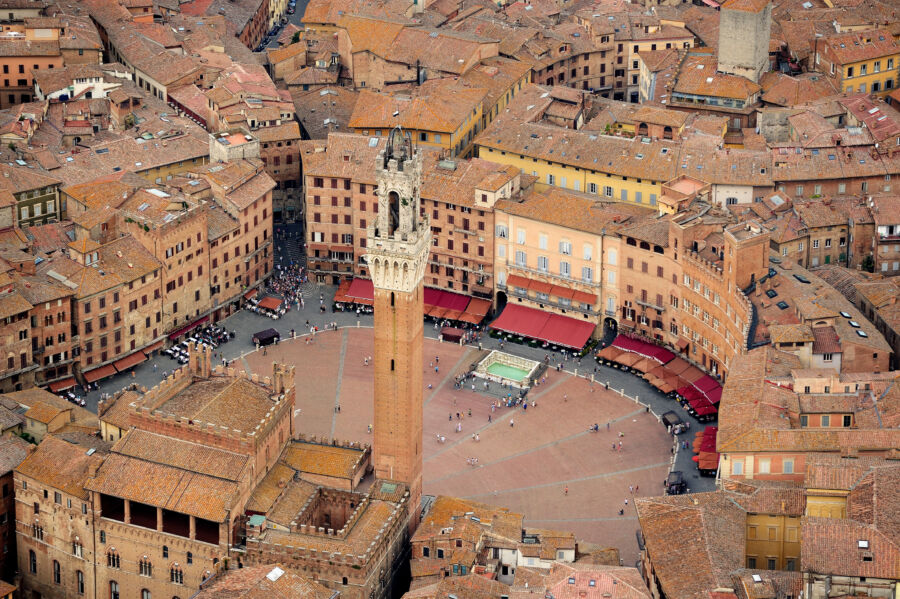
Siena’s world-famous Palio dominates the cultural calendar. This thrilling horse race takes place twice each summer in Piazza del Campo. The city splits into 17 competing districts called contrade, each with unique flags and symbols. The excitement builds for days before the race with parades, feasts, and neighborhood celebrations.
In September, Pienza celebrates its past as a Renaissance “ideal city” with the Feast of Pecorino cheese. Local shepherds parade through the streets while musicians play traditional songs. The smaller festivals here feel more intimate and less touristy.
Cuisine and Gastronomy
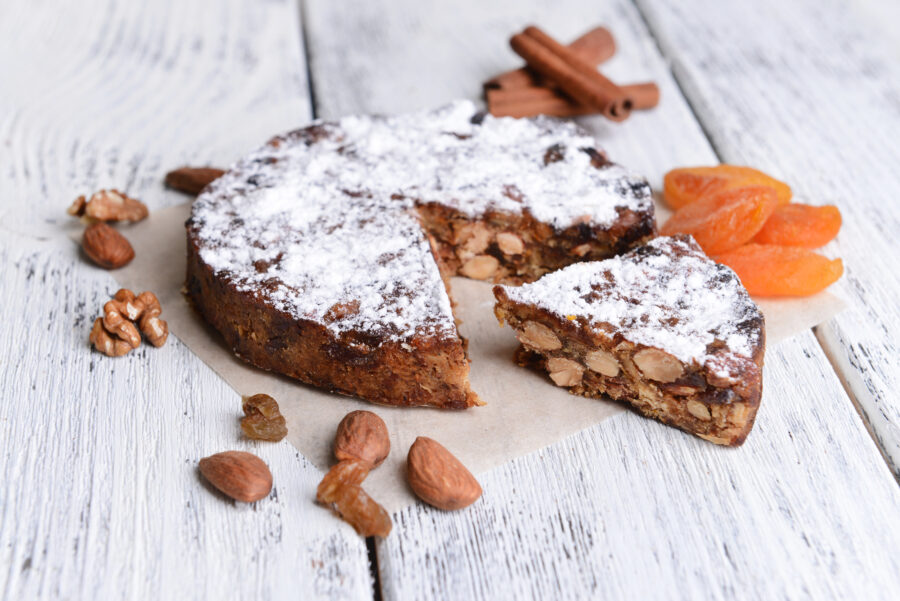
Pienza stands out for its famous pecorino cheese, which is made from sheep’s milk. Local producers age varieties in cellars beneath the town, and many shops offer complimentary tastings.
Siena specializes in sweet treats like panforte (fruit and nut cake) and ricciarelli (almond cookies). The city has excellent gelato shops, especially around Piazza del Campo.
Both towns serve classic Tuscan dishes, such as pici pasta with wild boar sauce and bruschetta drizzled with local olive oil.
Artisanship in Tuscany
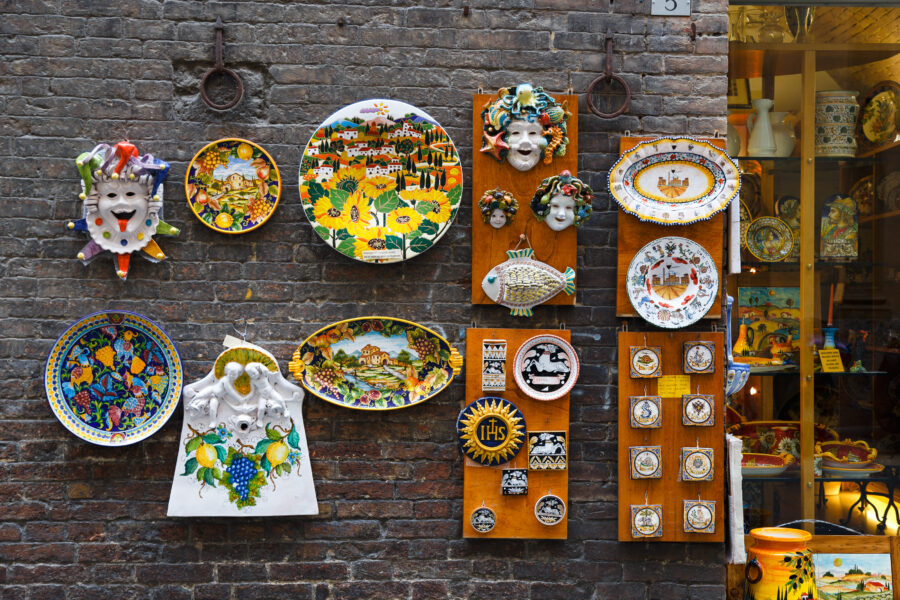
Siena’s narrow lanes hide workshops where artisans make ceramics, leather goods, and jewelry. Look for hand-painted majolica pottery featuring traditional patterns.
Pienza’s artisans focus on food-related crafts. Watch cheese makers at work or visit olive oil producers in restored farmhouses. The town is known for its handmade wooden cooking tools and ceramic serving pieces.
Small art galleries in both towns showcase local painters and sculptors who draw inspiration from the Tuscan landscape.
Natural Landscapes
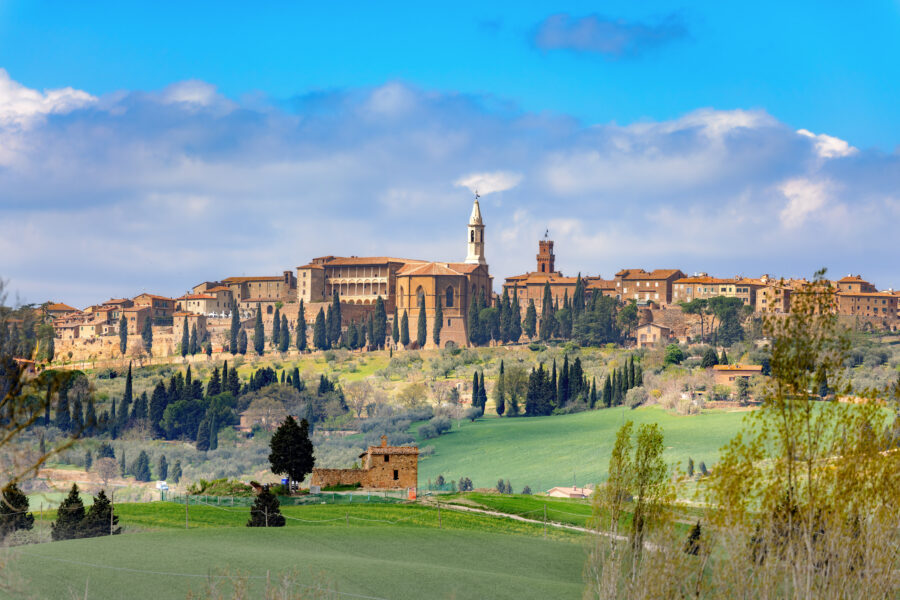
The landscapes surrounding these two Tuscan destinations offer distinct experiences. Pienza sits in the heart of the UNESCO-protected Val d’Orcia, while Siena is nestled among rolling hills and cypress-lined roads.
Val d’Orcia Natural Park
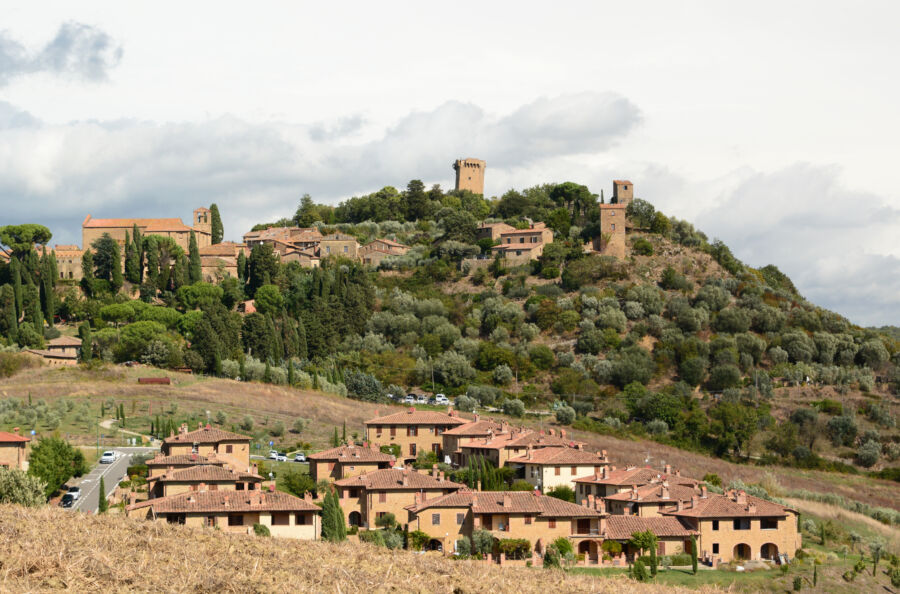
The Val d’Orcia Natural Park creates a picture-perfect backdrop for Pienza and Montepulciano. This UNESCO World Heritage site paints the quintessential Tuscan landscape that appears on postcards worldwide.
Rolling hills stretch as far as the eye can see, dotted with lonely cypress trees and ancient farmhouses. The colors change with the seasons – bright green in spring, golden wheat in summer, and rich browns in fall.
Visitors find the most photographed spots in Tuscany between Pienza and Montalcino. Little country roads wind through fields of sunflowers and vineyards, perfect for scenic drives or cycling adventures.
Tuscan Countryside
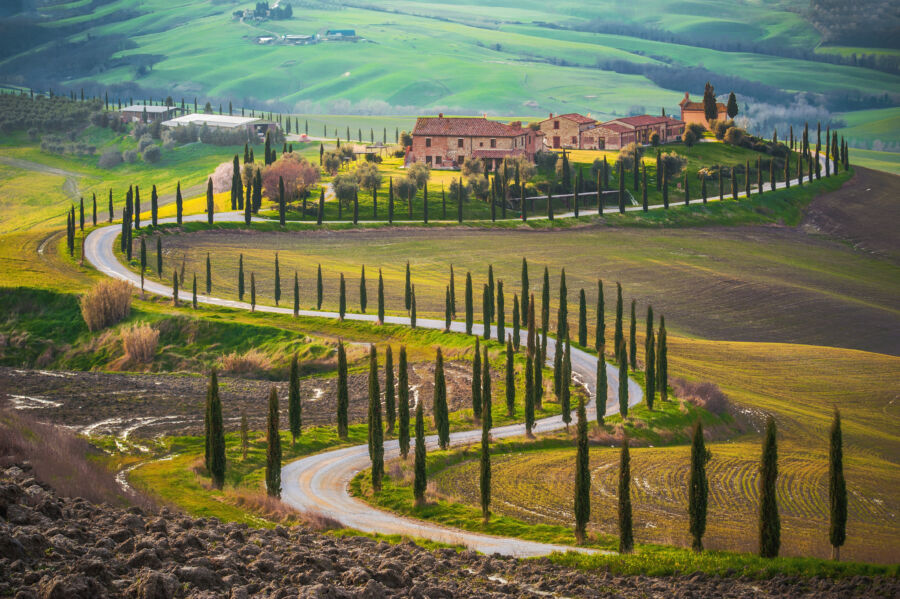
Siena’s surrounding countryside offers a different kind of beauty. The landscape features olive groves, vineyards, and dense woodlands.
The terrain near Siena is more varied and hilly than the Val d’Orcia. Medieval towers peek out from hilltop villages, creating a striking contrast against the natural setting.
Visitors can explore numerous hiking trails that connect small villages through shaded woods and open fields. The area between Siena and Montepulciano features some of the most scenic backroads in Tuscany.
The famous Crete Senesi region just outside Siena showcases unique clay hills that create an almost lunar landscape, especially striking at sunrise and sunset.
Travel and Accessibility
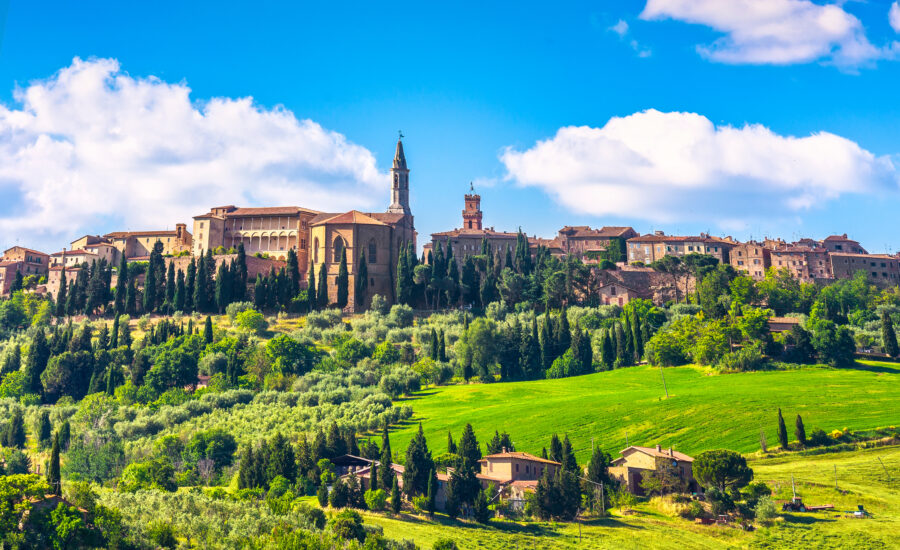
Getting between these two Tuscan gems requires careful planning. Each city offers distinct transport options and staying arrangements that shape the travel experience.
Getting to Pienza and Siena
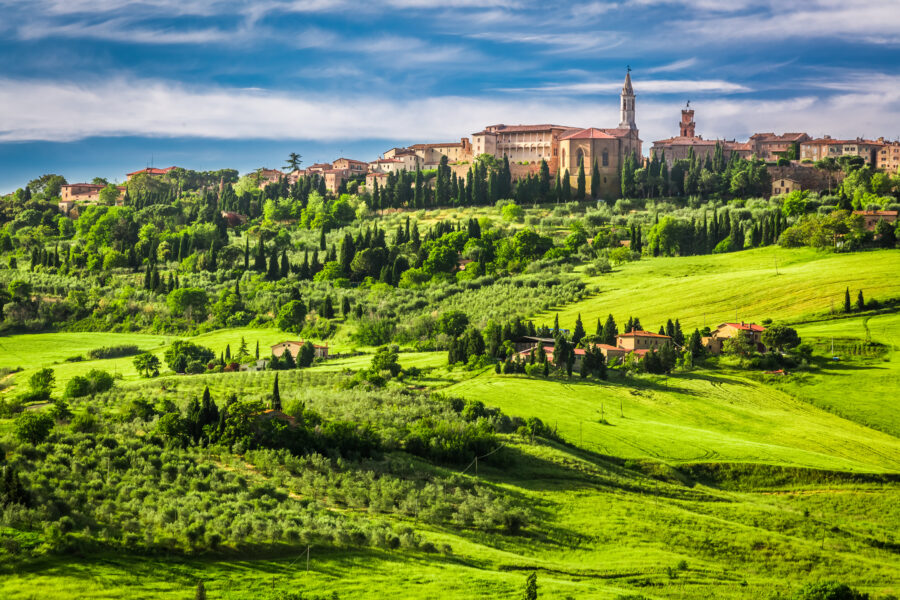
Siena is well-connected to major cities through bus and train networks. The closest airports are Florence Airport (about 1.5 hours by car) and Rome Airport (around 3 hours away). Train service runs frequently from Florence to Siena.
Pienza sits in a more remote location. The best way to reach it is by car or bus from Siena or Florence. Buses run several times daily, but schedules can be limited on weekends and holidays.
A rental car gives the most freedom to explore both places. The drive between them takes about 1.5 hours through scenic Tuscan countryside.
Accommodations and Stay

Siena offers many lodging choices, from budget hotels to luxury resorts. Most places cluster near the historic center. Book accommodations early during peak summer months and festival times.
Pienza offers smaller, intimate stays. The town specializes in charming bed and breakfasts and family-run hotels. Many visitors stay at an agriturismo, a farmhouse hotel in the surrounding countryside.
Both towns make great bases for day trips to Florence and other Tuscan spots. Siena works better for train travel, while Pienza suits those with a car who want a quieter rural setting.
See Related: Unforgettable Religious Tours in Italy: Transform Your Faith Journey in the Jubilee Year
Itineraries and Day Trips

Pienza and Siena are excellent bases for exploring Tuscany’s rich cultural heritage, wine regions, and historic towns. These cities offer unique starting points for unforgettable adventures through the rolling hills and medieval villages.
Pienza for History Buffs

The Renaissance town of Pienza makes a perfect starting point for exploring Val d’Orcia’s treasures. Visitors can start their morning at Palazzo Piccolomini, taking in the stunning architecture and gardens.
A short drive leads to the charming Montalcino, where wine enthusiasts can book wine tasting tours at traditional wineries. The famous Brunello wines steal the show here.
San Quirico d’Orcia is just 15 minutes away. It offers quiet streets and the stunning Horti Leonini gardens. The town’s Collegiate Church showcases remarkable Romanesque architecture.
Siena’s Charm for Food Lovers
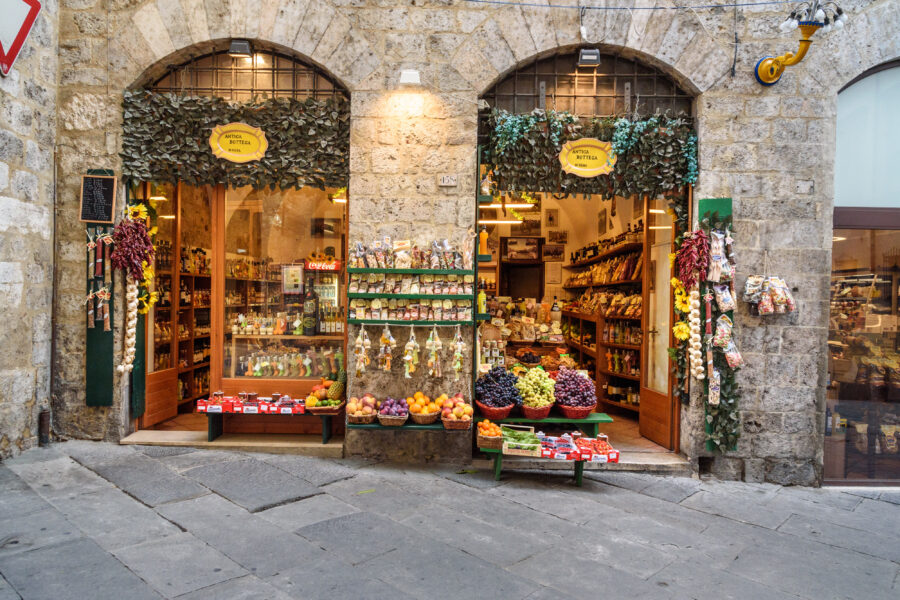
Siena’s central location makes it ideal for food-focused adventures. The morning can start with a visit to local markets where vendors sell fresh Pecorino cheese and traditional pastries.
Cooking classes teach visitors the secrets of Tuscan cuisine. Local chefs share recipes passed down through generations, from pici pasta to wild boar ragu.
The nearby Chianti region beckons with its vineyards and olive groves. Small family-run farms welcome guests for olive oil tastings and authentic farm-to-table meals.
Exploring Surrounding Towns

San Gimignano stands out with its medieval towers and world-famous gelato shops. It is just an hour from Siena and Pienza.
Volterra captivates visitors with its Etruscan ruins and alabaster workshops. Artisans still create beautiful pieces using ancient techniques.
The thermal town of Bagno Vignoni offers a unique experience with its central piazza filled with steaming water. The ancient Romans first discovered these healing springs.
Hidden gem Monteriggioni provides a glimpse into medieval military architecture with its perfectly preserved walls and towers.
Shopping and Retail
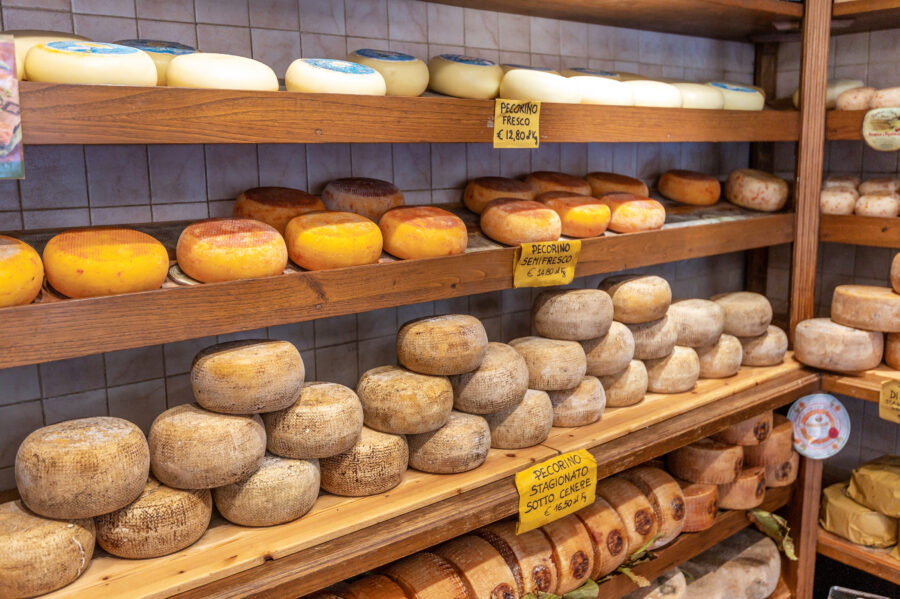
Both cities offer distinct shopping experiences. With its bustling markets and traditional shops, Siena shines, while Pienza excels in artisanal boutiques and specialty stores.
Local Markets in Siena
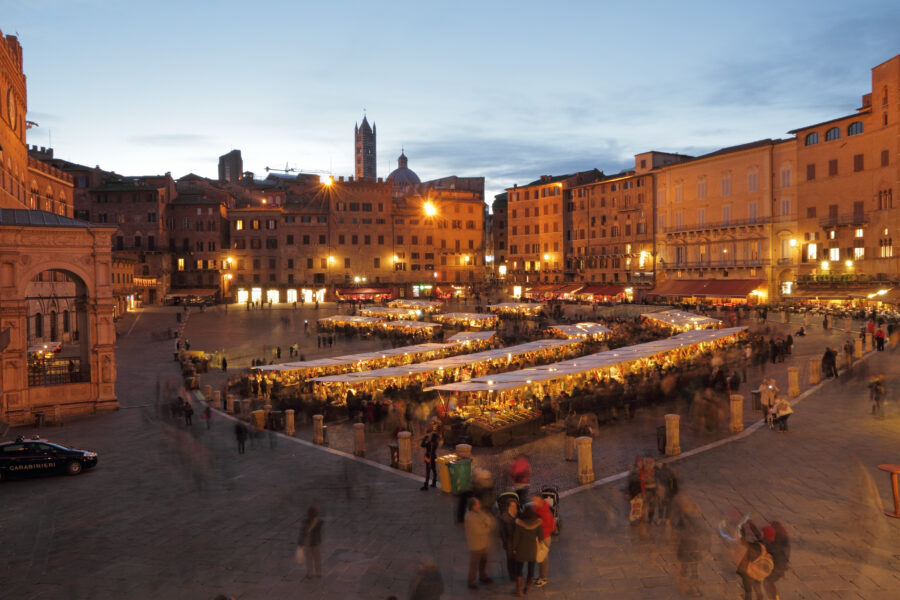
The Mercato nel Campo brings life to Siena’s main square twice weekly. Local vendors sell fresh produce, cheeses, meats, and handmade crafts from early morning until afternoon.
Inside the medieval streets, family-run shops showcase Tuscan specialties. You’ll find shops selling local wines, olive oils, and the famous panforte – a traditional Sienese dessert made with nuts and dried fruits.
The Via di Città and Via Banchi di Sopra form Siena’s main shopping streets. These roads host a mix of Italian fashion brands, leather goods stores, and souvenir shops selling ceramic pieces.
Boutiques of Pienza
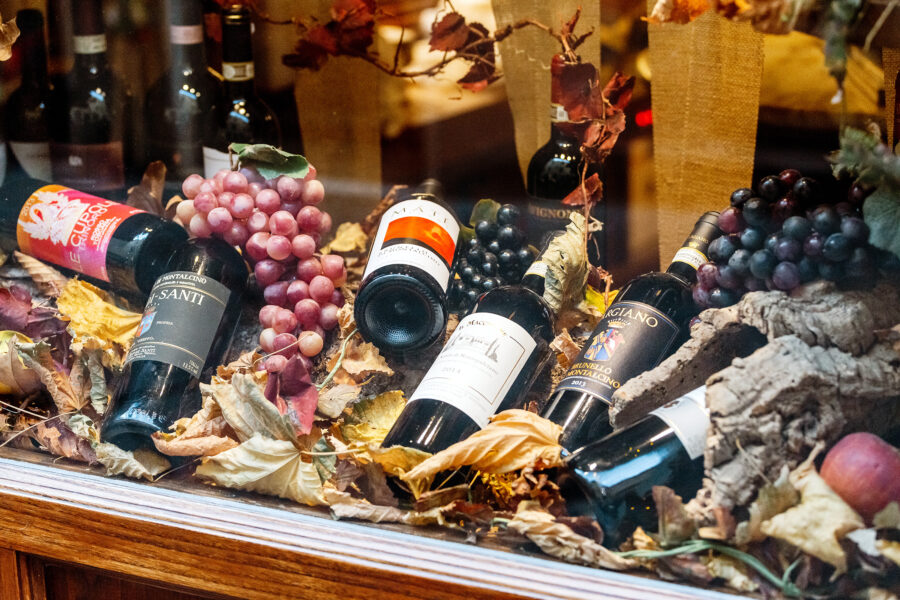
Pienza’s main shopping street, Corso Rossellino, features charming boutiques selling local pecorino cheese, wines, and handmade pasta.
Small artisan workshops dot the narrow lanes. These shops offer unique pottery, handcrafted jewelry, and traditional textiles made by local artists.
The town is famous for its specialty food stores. Before buying, many shops let visitors taste local products like truffle-infused oils, aged pecorino, and regional wines.
Look for the small leather workshops where craftsmen create custom bags and wallets using traditional methods.
See Related: What to Pack for Italy: Essential Gear for Your Dream Mediterranean Getaway
Frequently Asked Questions
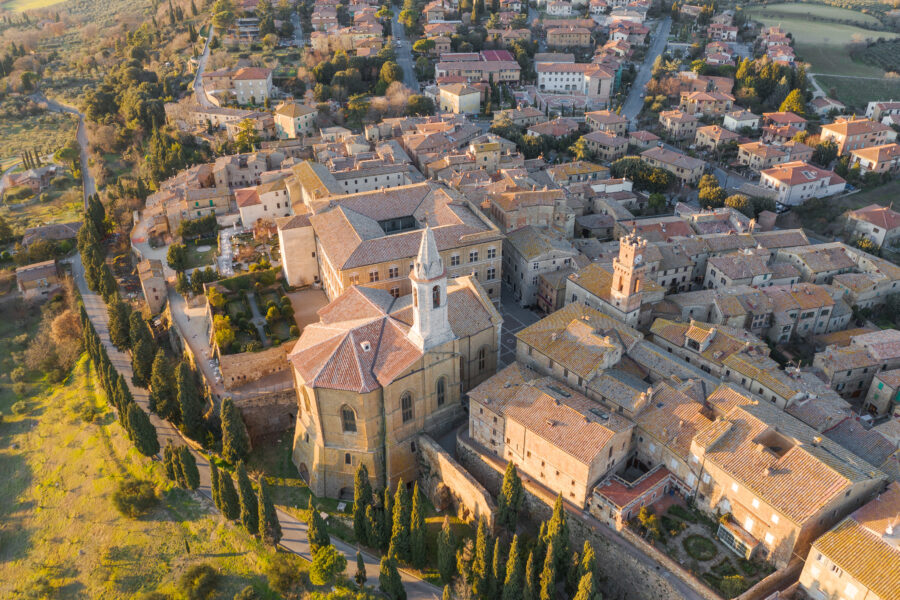
Tuscany’s historic gems, Pienza and Siena, offer distinct experiences, from Renaissance architecture to medieval traditions, amazing food, and yearly festivals that bring their streets to life.
What unique attractions can visitors discover in Pienza?
Pienza’s stunning Palazzo Piccolomini is the town’s crown jewel. It features magnificent Renaissance gardens with views of Val d’Orcia. The tiny historic center packs a punch with its perfectly preserved 15th-century urban planning.
The Cathedral of Pienza amazes visitors with its blend of Gothic and Renaissance styles. Its unique light-filled interior makes it a photographer’s dream.
How does the historical significance of Siena compare to that of Pienza?
Siena’s medieval heritage spans centuries, with the famous Palio horse race tradition dating back to the 1600s. The city was a major banking center during the Middle Ages.
The stunning black and white marble Siena Cathedral tells stories through intricate floor mosaics and art pieces. The city’s preserved Gothic architecture makes it feel like stepping into a medieval painting.
Can Pienza serve as a strategic hub for exploring the wider Tuscany region?
Pienza sits perfectly positioned between the Montalcino and Montepulciano wine regions. Its small size and free parking make it an easy base for day trips.
Travelers can reach charming towns like San Quirico d’Orcia and the Abbey of Sant’Antimo within 30 minutes by car. The Val d’Orcia’s famous rolling hills and cypress trees surround the city.
What are the can’t-miss cultural experiences when visiting Siena?
The Piazza del Campo comes alive each evening as locals gather for the traditional passeggiata. This shell-shaped square hosts the thrilling Palio races twice each summer.
The city’s seventeen contrade (districts) have unique symbols and traditions. Visiting their museums and churches gives insight into Siena’s rich community spirit.
How do the culinary offerings in Pienza stand out from those in nearby Tuscan towns?
Pienza’s pecorino cheese is world-famous for its complex flavors. Local shepherds still age their cheeses in caves beneath the town.
The town’s restaurants serve memorable yet straightforward dishes using local ingredients. Fresh pici pasta with sheep’s milk cheese sauce is one of many visitors’ favorite food memories.
What time of year is optimal for experiencing the festivals and events in Siena?
Siena’s famous Palio races are held on July 2 and August 16. If you plan to attend these exciting events, book accommodations months ahead.
Spring brings perfect weather for exploring, with fewer crowds than summer. The fall truffle and wine festivals add extra charm to an autumn visit.
